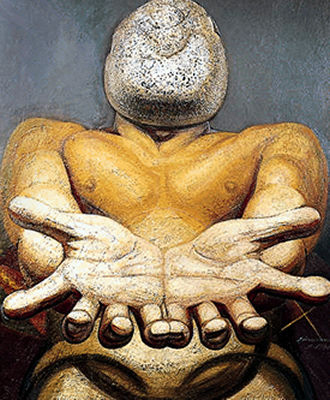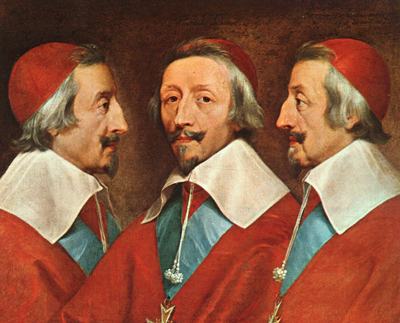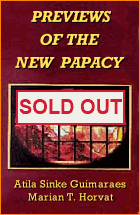Art & Architecture
 |
 |
 |
 |
 |
 |
 |
Painting of a Human Soul
A very frequent tendency in the artists whose works can typically be called "20th century" is the deformation of man. Fleeing from copying reality according to the way the human eye habitually sees it, they represent that reality with deliberate alterations in order, as they affirm, to express their most profound aspect.
In thesis, there is nothing wrong with this process. However, it is striking that, when they alter the normal aspects of reality, many artists, typically in the modern current, in fact deform reality almost to the horrendous.
 Thus, in modern paintings it is not difficult to find totally conical human figures: e.g., a tiny head, shoulders slightly broader than the head, a waist much wider than the shoulders, legs that seem to widen to the ankle to which literally immense feet are connected. In some sculptures, the necks are not only very thick, but deformed, presenting at one or another place alarming goiters.
Thus, in modern paintings it is not difficult to find totally conical human figures: e.g., a tiny head, shoulders slightly broader than the head, a waist much wider than the shoulders, legs that seem to widen to the ankle to which literally immense feet are connected. In some sculptures, the necks are not only very thick, but deformed, presenting at one or another place alarming goiters.
In short, if some magician appeared to any normally sane man and offered him a magic liqueur to transform his physiognomy and his body into that of a typical figure of modern art, such an offer would be followed by an immediate and energetic rejection...
This obsession for the deformed, the ugly, and even the horrendous has reached in certain artistic work the very limits of the inconceivable. See for example, the painting entitled Our Present-day Man [created by artist David Alfaro Siqueiros, 1947], which we publish here above left. It represents the moral image of the human race, as conceived by a typically ultramodern artist.
No one denies that there are terrible physical and moral deformities in the universe and that it is licit for an artist to represent them, provided there is no offense to good morals.
However, to paint only the horror, to paint or sculpt only to deform, as if the universe were nothing but an ensemble of ignominies, reveals a bad state of spirit and an indisputably false and dangerous conception both of man and the world.
This tendency toward the horrendous finds its roots in a desperate and blasphemous vision of Creation, which is the work of God. Paintings or sculptures made under the influence of this vision deform the soul; and ambiences impregnated with this state of mind can only degrade man, extinguishing in him every spurt of intelligence and will for a truly noble, pure and elevated ideal.
 By way of contrast, we present below a painting, drawn randomly from the immense artistic production of the past centuries that represents a man in his maturity.
By way of contrast, we present below a painting, drawn randomly from the immense artistic production of the past centuries that represents a man in his maturity.
Much more than the physical aspect of this man, the artist portrays his state of mind, his moral profile. The man portrayed is Richelieu [a 17th century Cardinal, nobleman and statesman], painted by Philippe de Champaigne in three different poses.
All the qualities – and also all the defects – of the great statesman are reflected in this admirable study, in which the human soul is portrayed in what it has of the most intimate, alive and subtle, without the artist having to resort to deformations that degrade human nature itself.

In thesis, there is nothing wrong with this process. However, it is striking that, when they alter the normal aspects of reality, many artists, typically in the modern current, in fact deform reality almost to the horrendous.

Our present-day man, David Alfaro Siqueiros, 1947
In short, if some magician appeared to any normally sane man and offered him a magic liqueur to transform his physiognomy and his body into that of a typical figure of modern art, such an offer would be followed by an immediate and energetic rejection...
This obsession for the deformed, the ugly, and even the horrendous has reached in certain artistic work the very limits of the inconceivable. See for example, the painting entitled Our Present-day Man [created by artist David Alfaro Siqueiros, 1947], which we publish here above left. It represents the moral image of the human race, as conceived by a typically ultramodern artist.
No one denies that there are terrible physical and moral deformities in the universe and that it is licit for an artist to represent them, provided there is no offense to good morals.
However, to paint only the horror, to paint or sculpt only to deform, as if the universe were nothing but an ensemble of ignominies, reveals a bad state of spirit and an indisputably false and dangerous conception both of man and the world.
This tendency toward the horrendous finds its roots in a desperate and blasphemous vision of Creation, which is the work of God. Paintings or sculptures made under the influence of this vision deform the soul; and ambiences impregnated with this state of mind can only degrade man, extinguishing in him every spurt of intelligence and will for a truly noble, pure and elevated ideal.

Armand Jean du Plessis. Cardinal Duke of Richelieu, by Philippe de Champaigne, 1637
Much more than the physical aspect of this man, the artist portrays his state of mind, his moral profile. The man portrayed is Richelieu [a 17th century Cardinal, nobleman and statesman], painted by Philippe de Champaigne in three different poses.
All the qualities – and also all the defects – of the great statesman are reflected in this admirable study, in which the human soul is portrayed in what it has of the most intimate, alive and subtle, without the artist having to resort to deformations that degrade human nature itself.

Catolicismo, n. 5, May 1951
Posted March 4, 2019
Posted March 4, 2019
______________________
______________________
 Volume I |
 Volume II |
 Volume III |
 Volume IV |
 Volume V |
 Volume VI |
 Volume VII |
 Volume VIII |
 Volume IX |
 Volume XI |
 Special Edition |
 Special Edition |


